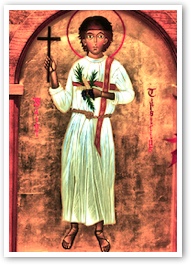Ah, Youth: When the Church Was Young
- MIKE AQUILINA
The Church Fathers had a distinctive approach to youth ministry. I discovered it in the course of an afternoon's research.
 Scouring the Patrologia Latina and Patrologia Graeca, I found nothing to suggest that Ambrose had ever led teens on ski trips to the nearby Alps. Digging through the Eastern Fathers, I came up even drier — no junior-high dances not even a pizza party in either Antioch or Alexandria. In fact, in all the documentary evidence from all the ancient patriarchates of the East and the West, there's not a single bulletin announcement for a single parish youth group.
Scouring the Patrologia Latina and Patrologia Graeca, I found nothing to suggest that Ambrose had ever led teens on ski trips to the nearby Alps. Digging through the Eastern Fathers, I came up even drier — no junior-high dances not even a pizza party in either Antioch or Alexandria. In fact, in all the documentary evidence from all the ancient patriarchates of the East and the West, there's not a single bulletin announcement for a single parish youth group.
Yet the Fathers had enormous success in youth and young-adult ministry. Many of the early martyrs were teens, as were many of the Christians who took to the desert for the solitary life. There's ample evidence that a disproportionate number of conversions, too, came from the young and youngish age groups.
How did the Fathers do it? They made wild promises.
They promised young people great things, like persecution, lower social status, public ridicule, severely limited employment opportunities, frequent fasting, a high risk of jail and torture, and maybe, just maybe, an early, violent death at the hands of their pagan rulers.
The Fathers looked young people in the eye and called them to live purely in the midst of a pornographic culture. They looked at some young men and women and boldly told them they had a calling to virginity. And it worked. Even the pagans noticed how well it worked.
The brightest young man in the empire's brightest city — a teenager named Origen of Alexandria — promised himself entirely to God in virginity. And, as he watched his father taken away to be killed, Origen would have gone along himself, turned himself in, if his mother had not hidden all his clothes. . . .
I searched volumes on the ancient liturgy, and I was unable to find a scrap of a Mass we'd call "relevant" today. There were no special Youth Masses. Yet there was an overwhelming eucharistic faith among the young people of the Church.
What made the Church attractive in the third century can make it just as attractive in the twenty-first. In the ancient world and in ours, young people want a challenge.
Tarcisius was a boy of third-century Rome. His virtue and devotion were so strong that the clergy trusted him to bring the Blessed Sacrament to the sick. Once, while carrying a pyx, he was recognized and set upon by a pagan mob. They flung themselves upon him, trying to pry the pyx from his hands, wanting more than anything to profane the Sacrament. Tarcisius' biographer, the fourth-century Pope Damasus, compared them to a pack of rabid dogs. Tarcisius "preferred to give up his life rather than yield up the Body of Christ."
Even at such an early age, Tarcisius was aware of the stakes. Jesus had died for love of Tarcisius. Tarcisius did not hesitate to die for love of Jesus.
What made the Church attractive in the third century can make it just as attractive in the twenty-first. In the ancient world and in ours, young people want a challenge. They want to love with their whole being. They're willing to do things the hard way — if people they respect make the big demands. These are distinguishing marks of youth. You don't find too many middle-aged men petitioning the Marines for a long stay at Parris Island. It's young men who beg for that kind of rigor.
The spiritual writer Father John Hugo told a cautionary tale, not from the ancient Church, but from the German Church of the early twentieth century. Youth leaders faced a country depressed and dejected from its defeat in World War I. Teens seemed aimless, with little hope for professional opportunity and no clear sense of patriotism or other ideals.
The German clergy made a conscious effort, then, to accentuate the positive. They decided to accommodate the country's weakness, avoid mentioning sacrifice, and downplay the cross and other "negative" elements of Christianity. They were big on nature hikes.
At the same time, there arose a man who called upon those same youth to give up everything for the sake of their country. "He put them in uniforms, housed them in barracks — in short, he demanded that they live a hard and laborious life." This man, Adolf Hitler, won the hearts of the youth. Because no young man or woman really wants to give his life away cheaply.
Tarcisius knew better. So do the kids in your parish.
 This is Meaghen Gonzalez, Editor of CERC. I hope you appreciated this piece. We curate these articles especially for believers like you.
This is Meaghen Gonzalez, Editor of CERC. I hope you appreciated this piece. We curate these articles especially for believers like you.
Please show your appreciation by making a $3 donation. CERC is entirely reader supported.

Acknowledgement
 Mike Aquilina. "Ah, Youth: When the Church Was Young." Lay Witness (May/June 2005): 56.
Mike Aquilina. "Ah, Youth: When the Church Was Young." Lay Witness (May/June 2005): 56.
This article is reprinted with permission from Lay Witness magazine. Lay Witness is a publication of Catholic United for the Faith, Inc., an international lay apostolate founded in 1968 to support, defend, and advance the efforts of the teaching Church.
The Author

 Mike Aquilina is vice president of the St. Paul Center for Biblical Theology. He is the author or co-author of fifty books including A History of the Church in 100 Objects, Seven Revolutions: How Christianity Changed the World and Can Change It Again, Yours is the Church: How Catholicism Shapes Our World, Good Pope, Bad Pope: Their Lives, Our Lessons, Love in the Little Things: Tales of Family Life, Living the Mysteries: A Guide for Unfinished Christians, Fathers of the Church: An Introduction to the First Christian Teachers, The Way of the Fathers: Praying with the Early Christians, and Praying in the Presence of Our Lord: With St. Thomas Aquinas. With Cardinal Donald Wuerl, he is the author of The Church: Unlocking the Secrets to the Places Catholics Call Home, and The Mass: The Glory, the Mystery, the Tradition. See Mike Aquilina's "The Way of the Fathers" blog here.
Mike Aquilina is vice president of the St. Paul Center for Biblical Theology. He is the author or co-author of fifty books including A History of the Church in 100 Objects, Seven Revolutions: How Christianity Changed the World and Can Change It Again, Yours is the Church: How Catholicism Shapes Our World, Good Pope, Bad Pope: Their Lives, Our Lessons, Love in the Little Things: Tales of Family Life, Living the Mysteries: A Guide for Unfinished Christians, Fathers of the Church: An Introduction to the First Christian Teachers, The Way of the Fathers: Praying with the Early Christians, and Praying in the Presence of Our Lord: With St. Thomas Aquinas. With Cardinal Donald Wuerl, he is the author of The Church: Unlocking the Secrets to the Places Catholics Call Home, and The Mass: The Glory, the Mystery, the Tradition. See Mike Aquilina's "The Way of the Fathers" blog here.




